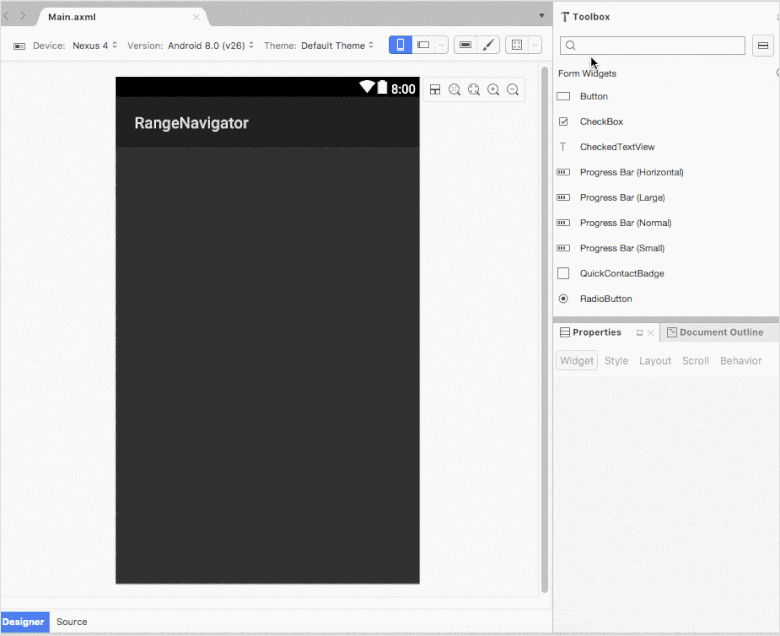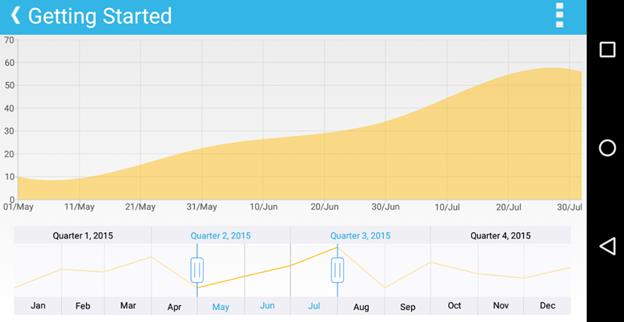Getting started in Xamarin.Android RangeNavigator
30 Nov 20222 minutes to read
This section walks you through the steps required to add SfDateTimeRangeNavigator and populate it with data, and also explains how to respond to range selection performed in the control.
Reference Essential Studio components in your solution
After installing Essential Studio for Xamarin, you can find all the required assemblies in the installation folders,
{Syncfusion Installed location}\Essential Studio\12.4.0.24\lib
NOTE
Assemblies are available in unzipped package location in Mac.
Add the following assembly references to the Android project,
android\Syncfusion.SfChart.Android.dll
IMPORTANT
Starting with v16.2.0.x, if you reference Syncfusion assemblies from trial setup or from the NuGet feed, you also have to include a license key in your projects. Please refer to this
linkto know about registering Syncfusion license key in your Xamarin application to use our components.
Initialize DateTimeRangeNavigator
SfDateTimeRangeNavigator allows users to drag the designer screen from toolbox to designer window. The properties window will be displayed where you change the necessary functionalities to customize the datetime range navigator in designer.

You can get the date time range navigator instance from axml page in MainActivity using the following code.
SfDateTimeRangeNavigator dateTimeRangeNavigator = FindViewById<SfDateTimeRangeNavigator>(Resource.Id.sfDateTimeRangeNavigator1);Add and configure the SfDateTimeRangeNavigator
First, let us initialize the control with major and minor date time scales by specifying the minimum and maximum date to be visualized in the control using Minimum and Maximum properties.
Following code example illustrates this,
[C#]
SfDateTimeRangeNavigator sfDateTimeRangeNavigator = new SfDateTimeRangeNavigator();
sfDateTimeRangeNavigator.Minimum = new GregorianCalendar(2015, 01, 01).Time;
sfDateTimeRangeNavigator.Maximum = new GregorianCalendar(2016, 01, 01).Time;
Handle range selection
In real time, other controls like chart, grid etc., are updated in response to the range selection performed in SfDateTimeRangeNavigator. You can handle the selection using RangeChanged event and update other controls based on the selected date time or perform some other tasks using the selected data.
NOTE
You can get the selected date time using
ViewRangeStartandViewRangeEnd.
Following code example illustrates how to handle range selection and update chart’s date time axis range,
[C#]
sfDateTimeRangeNavigator.RangeChanged += sfDateTimeRangeNavigator_RangeChanged;
void sfDateTimeRangeNavigator_RangeChanged(object sender, SfDateTimeRangeNavigator.RangeChangedEventArgs e)
{
//Updating chart's date time range
dateTimeAxis.Minimum = e.ViewRangeStart;
dateTimeAxis.Maximum = e.ViewRangeEnd;
}NOTE
Though the
Contentproperty’s data type is View and it can accept any View as its value, but currentlySfDateTimeRangeNavigatorcan accept onlySfChartas its content.
